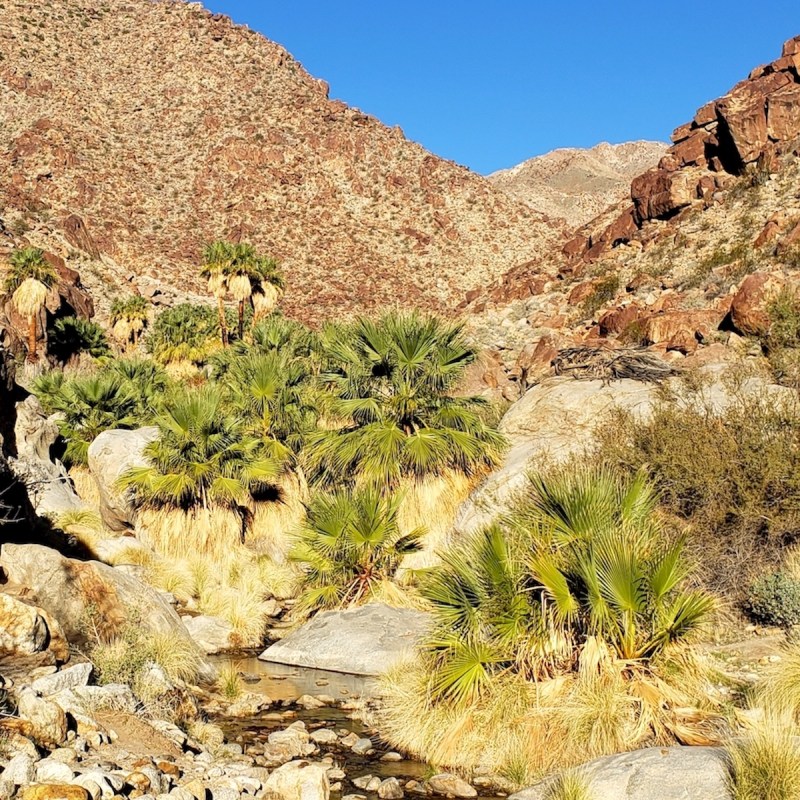
One of the best things about visiting Anza-Borrego State Park, the largest state park in California, is that often when you tell someone that you have been there or are planning to go there, they will exclaim, “Where’s that?”
Videos by TravelAwaits
Anza-Borrego Desert State Park at 640,000 acres, contains 96 percent of California’s wilderness areas and enables its visitors endless opportunities to explore, with 500 miles of dirt roads, 12 wilderness areas, and many miles of hiking. The park is in the Colorado Desert region of the Sonoran Desert in Southeastern California and surrounds the small town of Borrego Springs.

At the beautifully landscaped visitor center, you will find information about the area, including road conditions, camping spots, and local hikes. The diverse park features wildflowers, cactus, slot canyons, palm groves, Native American relics, and incredible vistas. Visitors also have the chance to see bighorn sheep, coyotes, jackrabbits, a wide variety of birds, iguanas, chuckwallas, and red diamond rattlesnakes.

I have been visiting the Anza-Borrego region for over 40 years and never tire of its quiet majesty. There are great opportunities for outdoor activities like golf, tennis, hiking, biking, and exploring many jeep roads with a four-wheel-drive vehicle. Both the state park and the Anza-Borrego Desert Natural History Association have a calendar of events, including docent-led nature hikes, stargazing with telescopes, ranger talks, and bird watching.
The park is so vast that it is easy to pull off the road and explore a wash or canyon. Just remember when you hike to let someone know where you are going and when you expect to return. Carry enough water, wear protective sun-gear and lotion, and carry a first aid kit.
Please, remember that dogs are not allowed on any park trail. Also, the desert ecosystem is fragile and it’s important to leave no trace, including any food scraps, which because of extreme dryness, takes a long time to decompose. Here are four of my favorite hikes.

1. Borrego Palm Canyon
Borrego Palm Canyon is a moderately strenuous trail that winds for 3.25 miles through a narrowing flash flood-prone canyon known as Tala by the Native American tribe of the area. It is an extremely popular trail because it leads to several native fan palm oases with a good possibility of spotting bighorn sheep along the way. It is especially popular in the spring because of the spectacular wildflowers and excellent birding. Water flows, especially in the winter, through a cascading series of pools, an awesome backdrop to the red-brown boulders of the San Ysidro Mountains that rise on either side. Expect some boulder scrambling and stream crossings, especially in the winter and spring.
The trail begins at the northwestern end of the Palm Canyon campground, which charges $10 per vehicle for entry. You may pick up a numbered nature guide at the beginning of the hike. Expect to spend 2 hours enjoying this hike with a 600-foot elevation gain. Make certain that you carry plenty of water, at least a liter per person, wear sun protection, and wear sturdy shoes. I wear a long-sleeved lightweight shirt. If possible, get an early start.
2. Glorieta Canyon
This minimally trafficked, moderately strenuous hike doesn’t have the palm oases of Borrego Palm Canyon, but from the saddle of the trail, you will be rewarded with great views of Borrego Valley, the Santa Rosa Mountains, and Font’s Point. Along this one-mile trail is a good sampling of desert vegetation, including ocotillo, teddy bear and barrel cactus, and jojoba, and depending on the time of year, colorful patches of wildflowers. The turn-off to this hike is at mile marker 8.6 on Borrego Springs Road, about 3.5 miles south of Christmas Circle in the town of Borrego Springs. After the road curves to the east, turn right (south) on the second dirt road after the fenced water pump. You do not need a four-wheel-drive vehicle, but do watch for sandy spots. Continue along the road south for 0.9 miles. Turn right (west) and proceed 0.3 miles, then turn left (south). Drive 0.5 miles and turn right (west). Drive 1.4 miles and park at the end of the road, which dead-ends at the trailhead.
The trail starts to the right up a narrow, rocky stream bed, and as you gain elevation, the canyon widens. Once you reach the saddle, you may choose to head up the ridge for a quarter-mile for an excellent overlook of the valley. Return the way you came or continue to the other side of the saddle. You may choose to hike along a wash heading west, or if you turn east, you will hike down a canyon that leads to the desert floor, where you will walk southwest again to find your car.
Remember to take water and wear a hat. Hiking poles are optional, but there are a few slippery places as you descend. During the warmer days of late spring, be wary of rattlesnakes that often curl in the shade of low-hanging rocks.
3. South Palm Wash
If you’re looking for a unique slot canyon that is easy to access and is relatively quiet, especially on weekdays, head for South Palm Wash, a moderately strenuous 3-mile round trip hike with short sections of beautiful, towering sandstone canyon walls. To get there, start at Christmas Circle and head 18 miles east on S22 to mile marker 38.2. Park in the dirt pull-out on your left and walk down the steep jeep road on the north end of the lot. At the bottom of the road is a wide, sandy wash, where you take a sharp left and continue for 0.6 miles, passing desert holly, creosote, and the delicate, blue-tone smoke tree. Walk about 100 feet to the natural sandstone bridge and continue up the wash 0.3 miles through a stunning slot canyon with 60- to 80-foot towering burnished sandstone walls on either side. If you look closely you may see the fossilized prints of camel hooves, as this area was once a lush wetland.
Eventually, after about 0.4 miles you will reach a dry waterfall, a bit too crumbly to attempt. Return the way you came. Expect sandy trail conditions. Carry water and wear lightweight long pants to avoid scraping knees and legs.
4. Kenyon Overlook
The Bill Kenyon Overlook trail is an easy 1.2-mile round trip hike across a hillside of granitic, weathered rock, which is lovely to explore, especially at sunrise or sunset. The parking for the trailhead is 6.8 miles from Christmas Circle. Drive 2.2 miles east on S22 and turn right on Borrego Valley Road. Continue past the intersection of Borrego Springs Road and drive for 4.8 miles on S3 (Yaqui Pass Road) then turn left into a large dirt parking area and primitive camp at mile marker 2.1. The trailhead is at the south end of the camp.
This well-defined trail leads south at a slight incline and then west to an overlook of the Mescal Bajada. The bajada is an immense alluvial fan consisting of rock that has eroded over thousands of years carried by flash floods washing from the surrounding mountains. The desert vegetation along the trail is diverse and includes agave, brittlebush with its bright yellow disk flowers, buckhorn cholla, and desert lavender, a bee favorite when it’s flowering. Near the overlook into the bajada is a memorial plaque dedicated to William L. Kenyon, the southern district superintendent of California State Parks in the 1950s.
You may continue up the ridge to your right or return the way you came. As when doing any desert hikes, protect yourself from the sun, carry plenty of water, and wear proper footwear.

More Borrego Springs Inspiration
Borrego Springs lies in the Borrego Valley, surrounded by the Santa Rosa, San Ysidro, Vallecito, and Jacumba mountains, and although the population is only about 3,000 people, the town has a newly built library, an art institute, grocery stores, restaurants, motels, and golf courses. Borrego Springs is known for its Sky Art Metal sculptures and its international designation as a Dark Sky Community. Many people come to the town just to see the unusual art pieces created by welder/artist Ricardo Breceda. He has crafted over 100 representations of animals that once roamed the land when the climate was tropical and covered by a huge inland lake named Lake Cahuilla. There are 10-foot-high elephants, saber-toothed tigers, and sloths, as well as sculptures of desert tortoises and wild horses.
Some of these fantastic works of art are pure fantasy, such as the giant serpent; others represent events in history such as the exploration by the Spanish explorer Juan Bautista de Anza, who was searching for an overland route from Mexico to Alta California. There are also sculptures of farmworkers tending to the vines of the huge DiGiorgio grape ranch in the 1950s.
It is best to have a map to visit the sites as some are hard to find. You may obtain a map from the Borrego Springs Chamber of Commerce on Palm Canyon Drive or by visiting the website of the Under the Sun Foundation.
For more California and desert inspiration, consider
